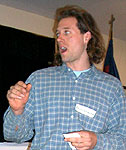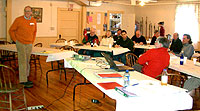
|
Beach Plum January 2004 Beach Plum Production & Marketing Meeting January 20, 2004 Dartmouth Grange No. 162, Dartmouth, Massachusetts | ||||||||
|
Home page Next Meeting: March 31 More info. |
Sponsored by a grant from the Northeast Region Sustainable Agriculture Research & Education Program (SARE). Participants at the meeting, Click for larger image.
Growers' panel  A panel of growers from Cape Cod and Long Island discussed the successes and challenges of the 2003 season, moderated by Jeff LaFleur, Cape Cod Cranberry Growers' Association. Larger image. View Rick Uva's presentation, 'Production Year In Review': Webpage (.html) | PowerPoint (.ppt)
Keith demonstrated chip budding (a grafting technique used propagate selected varieties), stressing the importance of cambial alignment. Growers have seedling orchards with a wide variety of yield and fruit quality. Eventually they may want to graft their best yielding plants onto rootstocks to increase their numbers. Budding may be the best method. Improved rootstocks can be used. For example, the Marianna 8-1 rootstock has vigorous growth and tolerates poorly drained sites, potentially making beach plum adaptable to a wide range of soil types. Compatibility of this rootstock with beach plum is still unknown. Keith's future work will examine rootstock compatibility. He is testing 8 different beach plum scions for compatibility with several Prunus rootstocks. So far he has found that the scions he is working with are free of common plum viruses that are known to interfere with graft compatibility. In other propagation research, cuttings performed better when taken at a very young softwood stage, which is different than what was reported in the literature. There was a significant difference in ability to root between plants.   Lunch was a time to visit and sample beach- and sand plum jellies.
Tom Whitlow (above, standing left) lead a discussion focusing on the development of a beach plum consortium. The consortium could consist of growers and processors and others who are interested in growing, processing and marketing beach plum products. Communication among all sectors of this developing industry would help it flourish. Concept mapping, a way to generate pictures that describe ideas, was employed during Tom's session by Ken Mudge (above, sitting right in red shirt) of Cornell University. The "big picture" created below documents the interwoven ideas and concepts that emerged as the discussion progressed. 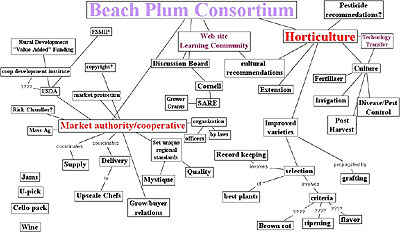 Larger view. After the meeting ... 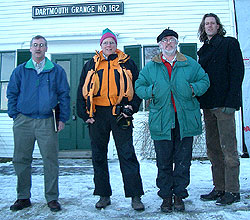 Bob Weybright, Tom Whitlow, Ken Mudge and Keith Vanderhye (l. to r.) prepare to hit the road ... 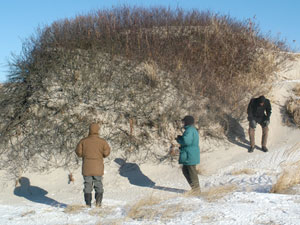 ... but first the crew checks out a large, wild-growing beach plum around which a sand dune apparently formed at Westport Point in Westport, Mass. ... [Larger image]  ... and Ken Mudge collects bud wood for more propagation and grafting research in the beach plum orchard at Coonamessett Farm, Falmouth Mass. [Larger image] |


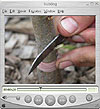 Download budding
Download budding 